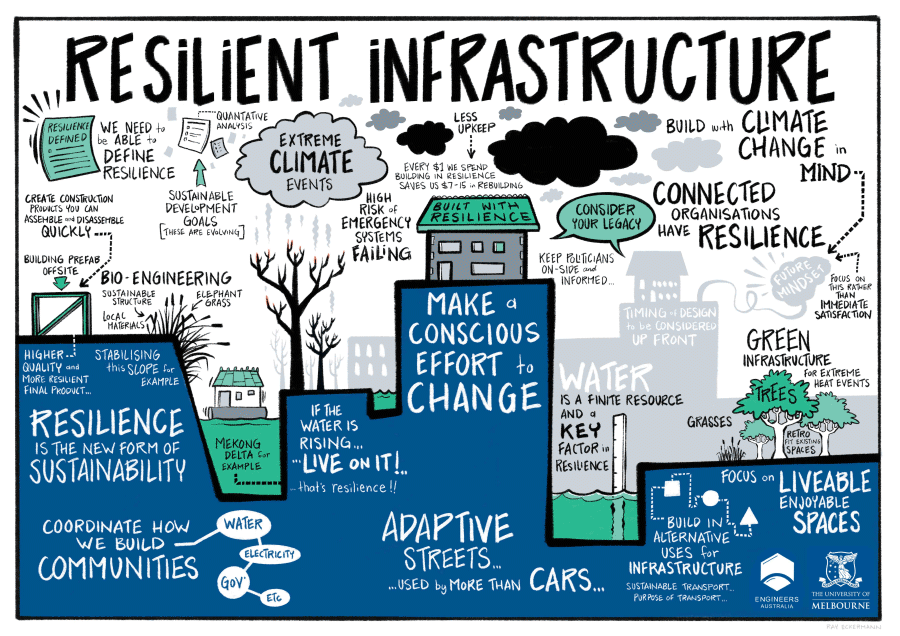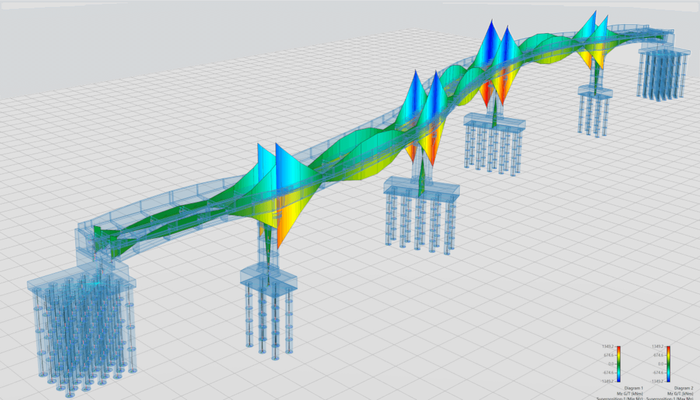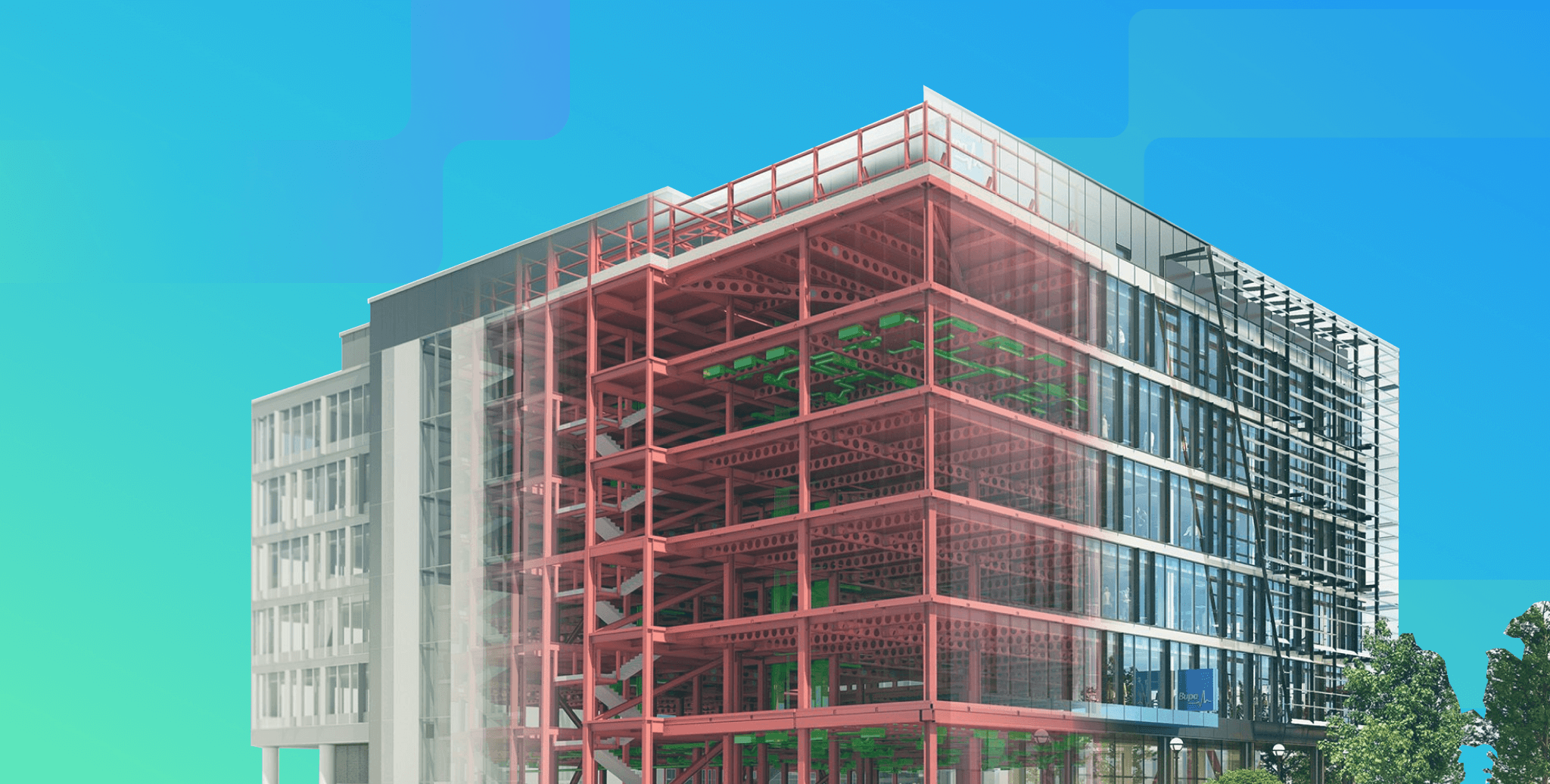How to Best Use BIM for Resilient Infrastructure Development?

Table of Contents
Adapting to challenging life experiences demands resilience, which is both a process and result, achieved by showcasing mental, emotional, and behavioural flexibility. When applying this idea to the built environment, it translates to creating spaces that make people feel stronger, safer, and more agile helps in creating a healthier global community. This improves people’s quality of life, making the world a better place to live.
What is a Resilient Infrastructure?
Infrastructure resilience refers to the ability of a system or structure to withstand and recover from disruptive events while maintaining its functionality. These unruly events can include natural disasters such as earthquakes, floods, hurricanes, tsunamis, and wildfires, alongside human-made disasters like wars and terrorism.
Why Do We Need Infrastructure Resilience?

Given the alarming rate of rapid population explosion, global warming, and natural disasters, the need for resilient infrastructure is more than ever now. A key instance supporting this statement is the outbreak of the Russia-Ukraine war. The war caused significant damage of about $50 billion to housing facilities in Ukraine between February 2022 and February 2023. An additional $36 billion was marked in losses from damage to infrastructure. (Source: Statista)
An example of a natural calamity impacting building infrastructure would be the Kedarnath flash floods in India in 2013. While it has already been a decade since the disaster, the reconstruction of Kedarnath is yet to be finished. This has impacted the local economy, displaced people from their ancestral homes, and affected the community.
Therefore, to navigate and abate such circumstances, the world of tomorrow has to be more adept at dealing with crises and bouncing back even stronger. Creating strong and durable roads, bridges, water supply and drainage networks, transportation systems, electricity grids, and telecommunication towers, while making provision for other public amenities is vital to ensure that the future built environment is more holistic.
What are the Characteristics of Resilient Infrastructure?

Creating infrastructure resilience requires meticulous planning and strategising. Let’s have a look at its key features.
1. Adaptability and Agility
Resilient infrastructure is designed to adapt to changing conditions and unexpected challenges. This may involve flexible design, modularity, and the ability to incorporate new technologies or measures when needed.
2. Robustness and Longevity
Strength and durability are fundamental to resilient infrastructure so that it can withstand the impact of various stressors without suffering catastrophic failures. This may involve using high-quality materials, advanced engineering, and adherence to strict construction standards.
3. Resource Efficiency
Infrastructure resilience should use resources efficiently, including energy, water, and building materials. This can contribute to sustainability and enhance the ability of the system to bounce back after any disruption.
4. Risk Assessment and Planning
A thorough understanding of potential downfalls contributes to the development of resilient infrastructure. This includes comprehensive risk assessments, contingency planning, and the integration of risk management strategies into the design and operation of the infrastructure.
5. Community Involvement
The successful implementation of infrastructure resilience takes into account the needs and perspectives of the communities it serves. Engaging with local communities helps ensure that infrastructure is both effective and socially equitable.
How Can Technology Help In Building Infrastructure Resilience?

Technology plays a pivotal role in enhancing resilient infrastructure by providing innovative solutions and tools that can mitigate risks and improve adaptive capabilities.
Smart technologies, such as the Internet of Things (IoT), facilitate the collection and analysis of vast amounts of data, aiding in the development of predictive models for identifying risks and optimising resource allocation. Artificial intelligence (AI) and machine learning also contribute to risk prediction and response optimisation, enhancing decision-making processes.
The use of resilient materials and innovative construction techniques, often guided by technological advancements, ensures that infrastructure can withstand and recover from various shocks. Building Information Modelling (BIM), in particular, has emerged as one of the strongest technologies enabling architects to design and implement projects that are resilient at their core.
How Does BIM Help in Resilience Planning and Design?

BIM is a digital process that involves the creation of a comprehensive 3D model of a building or infrastructure project, integrating various aspects such as design, construction, and operation. It serves as a collaborative platform where architects, engineers, contractors, consultants, and other stakeholders can work simultaneously. They can share information, insights, and material specifications throughout the project lifecycle, making it more efficient in terms of time, quality, and cost.
Here is a detailed note about how BIM aids in resilient infrastructure planning during times of emergencies.
1. Comprehensive Risk Assessment
BIM facilitates a detailed analysis of potential risks and vulnerabilities in infrastructure projects. By creating a virtual environment where various stressors can be simulated, planners can identify weak building components and propose design interventions to enhance resilience. This comprehensive risk assessment allows for proactive measures rather than reactive responses.
2. Early Detection and Mitigation
Resilience planning requires the ability to foresee challenges and address them before they escalate. BIM's real-time monitoring and simulation capabilities enable the foremost detection of issues, allowing stakeholders to implement mitigation strategies promptly. This approach minimises the impact of disruptions, ensuring the smooth functioning of infrastructure systems.
3. Collaborative Decision-Making
Building resilient infrastructure is a collaborative effort that involves input from multiple stakeholders. BIM serves as a central hub for collaborative decision-making, fostering communication and coordination among designers, engineers, and other project participants.
4. Optimised Design for Resilience
BIM's data-driven approach empowers designers to optimise their plans for resilient infrastructure. Through simulations and analysis, designers can identify areas for improvement, whether that is using more robust materials, incorporating redundancy in critical systems, or adapting the design to better withstand environmental challenges.
5. Lifecycle Management and Adaptability
Resilience planning extends beyond the initial construction phase. BIM supports lifecycle management by providing a digital record of the infrastructure. This information aids in efficient maintenance and allows for adaptations over time. Infrastructure designed with BIM remains adaptable, and capable of evolving to meet changing needs and emerging challenges.
Using BIM to Create Resilient Buildings and Structures

BIM is strengthening the prospects of resilient infrastructure by ensuring that every stage of the design and construction process is well-rounded for adaptability. Let’s understand how this helps.
1. Building Strongly and Efficiently
-
Comprehensive Digital Design
BIM's ability to create the 3D model of a structure enables architects to design for strength and efficiency. Professionals can collaborate on the shared iterative parametric model, ensuring that every element is meticulously planned, updated, and optimised for performance. This precision in design translates to buildings that are not only strong but also resource-efficient.
-
Material Optimisation
Through BIM, designers can analyse and optimise the materials used in construction, aiding resilient infrastructure. This involves choosing materials with proven durability, resilience to local environmental factors, and the ability to withstand stressors. BIM facilitates informed decisions that contribute to the creation of structures that hold strong against lateral loads in times of earthquakes, floods, and cyclones.
2. Contributing to Risk Reduction
-
Risk Analysis and Simulation
BIM's capabilities extend to risk analysis and simulation. By creating virtual environments, planners can simulate various scenarios such as tsunamis and earthquakes. This enables the implementation of risk reduction strategies during the design and planning phases, minimising the likelihood of issues arising during construction and throughout the building's lifecycle.
-
Redundancy Planning
Resilient infrastructure often incorporates redundancy in critical systems. BIM allows designers to plan for redundancy by simulating the performance of backup systems and ensuring that the building can maintain essential functions even in the face of failures. This redundancy planning enhances the overall reliability and resilience of the structure.
3. Preparing for Disaster Response
-
Emergency Preparedness
BIM can be instrumental in emergency preparedness by providing detailed information about the building's layout, systems, and utilities. This information is invaluable for first responders in the event of a disaster who are in a hurry to evacuate the building. Quick access to critical data enhances response times and facilitates more effective and targeted emergency efforts.
-
Evacuation Planning
To aid resilient infrastructure, BIM allows for the creation and visualisation of evacuation routes, emergency exits, and safe assembly points. This ensures that occupants can swiftly and safely evacuate the building during emergencies.
4. Aiding Post-Disaster Reconstruction
-
Digital Documentation for Reconstruction
In the unfortunate event of a disaster, BIM's role extends to post-disaster reconstruction. The detailed digital documentation created during the design and construction phases becomes a valuable resource for assessing damage, planning reconstruction efforts, and streamlining the rebuilding process.
-
Efficient Reconstruction Strategies
BIM facilitates efficient reconstruction by providing accurate and up-to-date information about the structure. This includes the original design, materials used, and any modifications made during the building's lifecycle. This wealth of information aids in streamlining the reconstruction process, ensuring that the rebuilt structure is resilient and optimised for long-term performance.
Examples of BIM In Action for Post-Disaster Reconstruction
The use of BIM has helped countries worldwide to reconstruct and restore their infrastructural glory. Below are two noteworthy examples of how BIM can prove helpful in times of disaster mitigation, enabling the development of disaster-resilient infrastructure.
1. The Post-Disaster Construction of Odisha, India
Cyclone Fani, the strongest cyclone to hit Orissa in two decades, struck India’s eastern coast in 2019. It left a trail of destruction across Odisha, notably impacting the city of Puri.
In response to the aftermath, BIM emerged as a pivotal tool in evaluating the structural damage inflicted upon public buildings, schools, and hospitals. The technology played a vital role in conceptualising and implementing reconstruction initiatives that integrated new construction methods and materials resilient to cyclonic conditions. BIM models were instrumental in ensuring that the reconstruction endeavours adhered to contemporary resilient infrastructure standards, fortifying communities against potential cyclone-related disasters in the future.
2. The Post-Disaster Construction of Kathmandu, Nepal
In 2015, Nepal experienced a catastrophic earthquake, particularly in historically significant areas like Kathmandu Valley. As reconstruction endeavours unfolded, the challenge lay in safeguarding the rich cultural heritage while bolstering seismic resilience.
BIM was utilised to generate intricate 3D models, capturing the damage incurred by heritage structures, including temples and palaces. These detailed models served as valuable tools for evaluating the structural stability of historic buildings, supporting the strategic planning of restoration initiatives and building resilient infrastructure. Leveraging BIM's 3D visualisation capabilities proved crucial in effectively communicating the reconstruction strategies to stakeholders and the impacted community.
In Conclusion
As we navigate an era of increasing challenges, BIM offers a dynamic platform for collaborative planning, risk mitigation, and adaptive design. So, if you are an Architecture, Engineering, or Construction (AEC) professional, learning BIM can be highly rewarding for your career. With BIM proficiency, you can contribute to projects that stand the test of time and maintain a strong footing in times of crisis.
If you wish to learn BIM for resilient infrastructure planning and design, we recommend you check out the BIM Professional Course for Civil Engineers by Novatr. The course offers insights into the functionalities, workflows, and software of BIM, giving a real-time perspective of how things work in practice.
Explore the course today!

 Thanks for connecting!
Thanks for connecting!




.png)






